Decision Making in Business: NPV, Payback, and Factors Essay
VerifiedAdded on 2023/01/11
|8
|1323
|57
Essay
AI Summary
This essay delves into the critical aspects of business decision-making, emphasizing the significance of evaluating investment opportunities through methods like Net Present Value (NPV) and payback period analysis. The essay highlights how managers can assess the profitability of potential projects, such as acquiring software or a laundrette service, by applying these techniques to determine the most financially sound decisions. It underscores the benefits and drawbacks of both NPV and payback period, providing calculations to illustrate their application. Furthermore, the essay considers the influence of both financial factors, such as interest rates and taxation, and non-financial factors, like regulatory changes, on the overall decision-making process. It concludes by reinforcing the necessity of a comprehensive approach to decision-making that incorporates a thorough examination of all available alternatives and relevant factors to achieve optimal business outcomes.
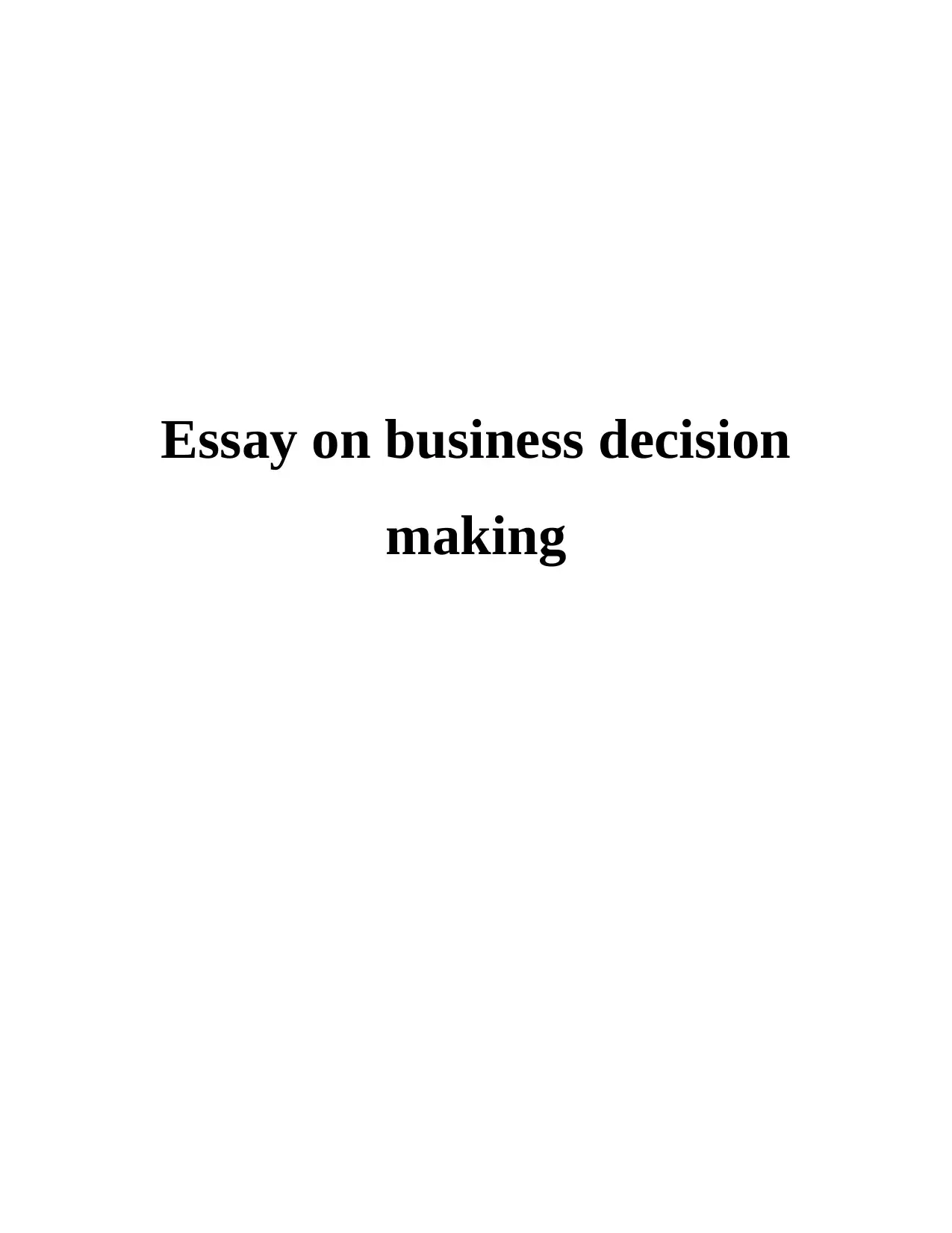
Essay on business decision
making
making
Paraphrase This Document
Need a fresh take? Get an instant paraphrase of this document with our AI Paraphraser

Contents
ESSAY TOPIC................................................................................................................................1
INTRODUCTION...........................................................................................................................1
ESSAY BODY................................................................................................................................1
Net present value with its benefits and drawbacks......................................................................1
Payback period with its benefits and drawbacks.........................................................................3
Financial and non-financial factors.............................................................................................4
CONCLUSION................................................................................................................................5
REFERENCES................................................................................................................................6
ESSAY TOPIC................................................................................................................................1
INTRODUCTION...........................................................................................................................1
ESSAY BODY................................................................................................................................1
Net present value with its benefits and drawbacks......................................................................1
Payback period with its benefits and drawbacks.........................................................................3
Financial and non-financial factors.............................................................................................4
CONCLUSION................................................................................................................................5
REFERENCES................................................................................................................................6
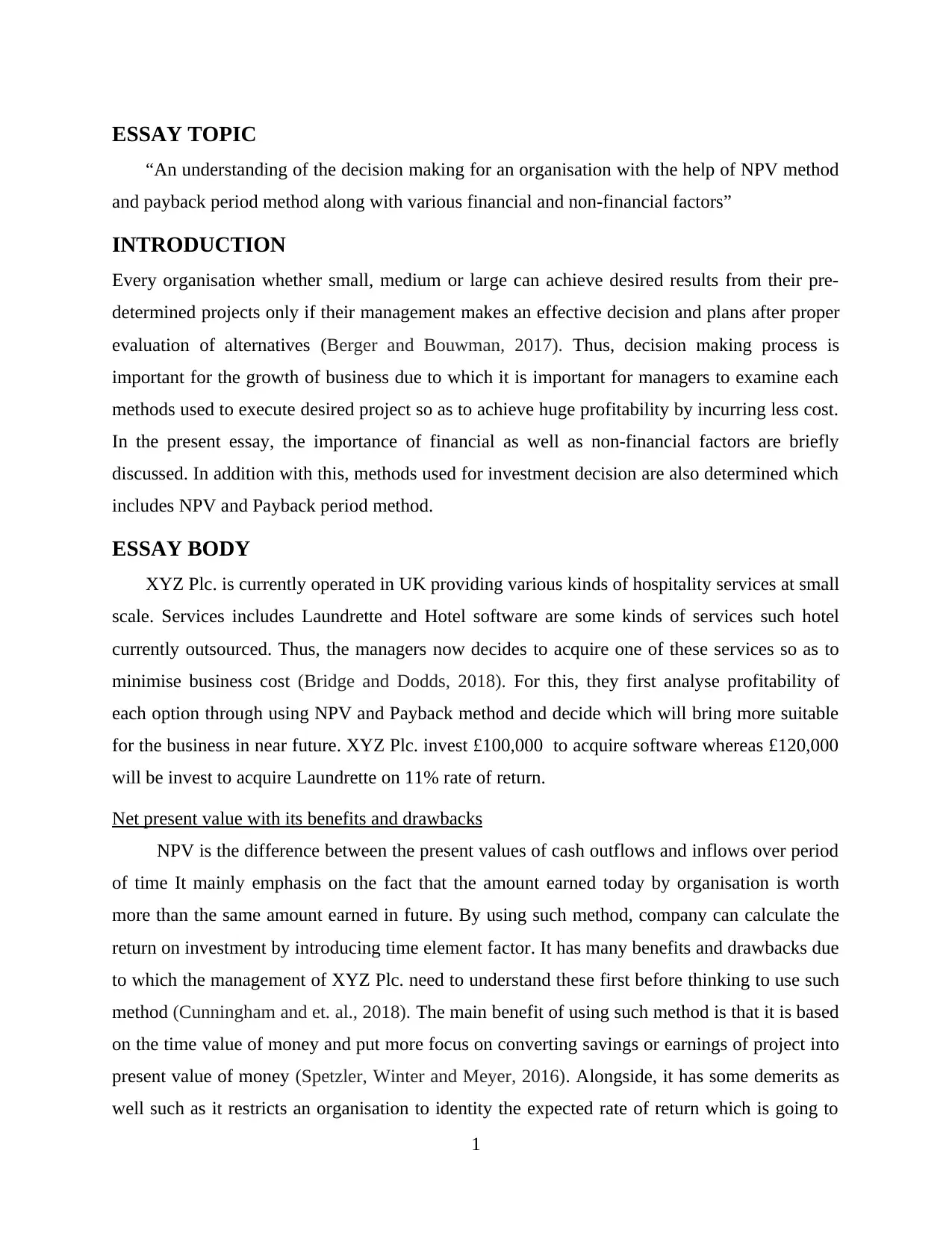
ESSAY TOPIC
“An understanding of the decision making for an organisation with the help of NPV method
and payback period method along with various financial and non-financial factors”
INTRODUCTION
Every organisation whether small, medium or large can achieve desired results from their pre-
determined projects only if their management makes an effective decision and plans after proper
evaluation of alternatives (Berger and Bouwman, 2017). Thus, decision making process is
important for the growth of business due to which it is important for managers to examine each
methods used to execute desired project so as to achieve huge profitability by incurring less cost.
In the present essay, the importance of financial as well as non-financial factors are briefly
discussed. In addition with this, methods used for investment decision are also determined which
includes NPV and Payback period method.
ESSAY BODY
XYZ Plc. is currently operated in UK providing various kinds of hospitality services at small
scale. Services includes Laundrette and Hotel software are some kinds of services such hotel
currently outsourced. Thus, the managers now decides to acquire one of these services so as to
minimise business cost (Bridge and Dodds, 2018). For this, they first analyse profitability of
each option through using NPV and Payback method and decide which will bring more suitable
for the business in near future. XYZ Plc. invest £100,000 to acquire software whereas £120,000
will be invest to acquire Laundrette on 11% rate of return.
Net present value with its benefits and drawbacks
NPV is the difference between the present values of cash outflows and inflows over period
of time It mainly emphasis on the fact that the amount earned today by organisation is worth
more than the same amount earned in future. By using such method, company can calculate the
return on investment by introducing time element factor. It has many benefits and drawbacks due
to which the management of XYZ Plc. need to understand these first before thinking to use such
method (Cunningham and et. al., 2018). The main benefit of using such method is that it is based
on the time value of money and put more focus on converting savings or earnings of project into
present value of money (Spetzler, Winter and Meyer, 2016). Alongside, it has some demerits as
well such as it restricts an organisation to identity the expected rate of return which is going to
1
“An understanding of the decision making for an organisation with the help of NPV method
and payback period method along with various financial and non-financial factors”
INTRODUCTION
Every organisation whether small, medium or large can achieve desired results from their pre-
determined projects only if their management makes an effective decision and plans after proper
evaluation of alternatives (Berger and Bouwman, 2017). Thus, decision making process is
important for the growth of business due to which it is important for managers to examine each
methods used to execute desired project so as to achieve huge profitability by incurring less cost.
In the present essay, the importance of financial as well as non-financial factors are briefly
discussed. In addition with this, methods used for investment decision are also determined which
includes NPV and Payback period method.
ESSAY BODY
XYZ Plc. is currently operated in UK providing various kinds of hospitality services at small
scale. Services includes Laundrette and Hotel software are some kinds of services such hotel
currently outsourced. Thus, the managers now decides to acquire one of these services so as to
minimise business cost (Bridge and Dodds, 2018). For this, they first analyse profitability of
each option through using NPV and Payback method and decide which will bring more suitable
for the business in near future. XYZ Plc. invest £100,000 to acquire software whereas £120,000
will be invest to acquire Laundrette on 11% rate of return.
Net present value with its benefits and drawbacks
NPV is the difference between the present values of cash outflows and inflows over period
of time It mainly emphasis on the fact that the amount earned today by organisation is worth
more than the same amount earned in future. By using such method, company can calculate the
return on investment by introducing time element factor. It has many benefits and drawbacks due
to which the management of XYZ Plc. need to understand these first before thinking to use such
method (Cunningham and et. al., 2018). The main benefit of using such method is that it is based
on the time value of money and put more focus on converting savings or earnings of project into
present value of money (Spetzler, Winter and Meyer, 2016). Alongside, it has some demerits as
well such as it restricts an organisation to identity the expected rate of return which is going to
1
⊘ This is a preview!⊘
Do you want full access?
Subscribe today to unlock all pages.

Trusted by 1+ million students worldwide
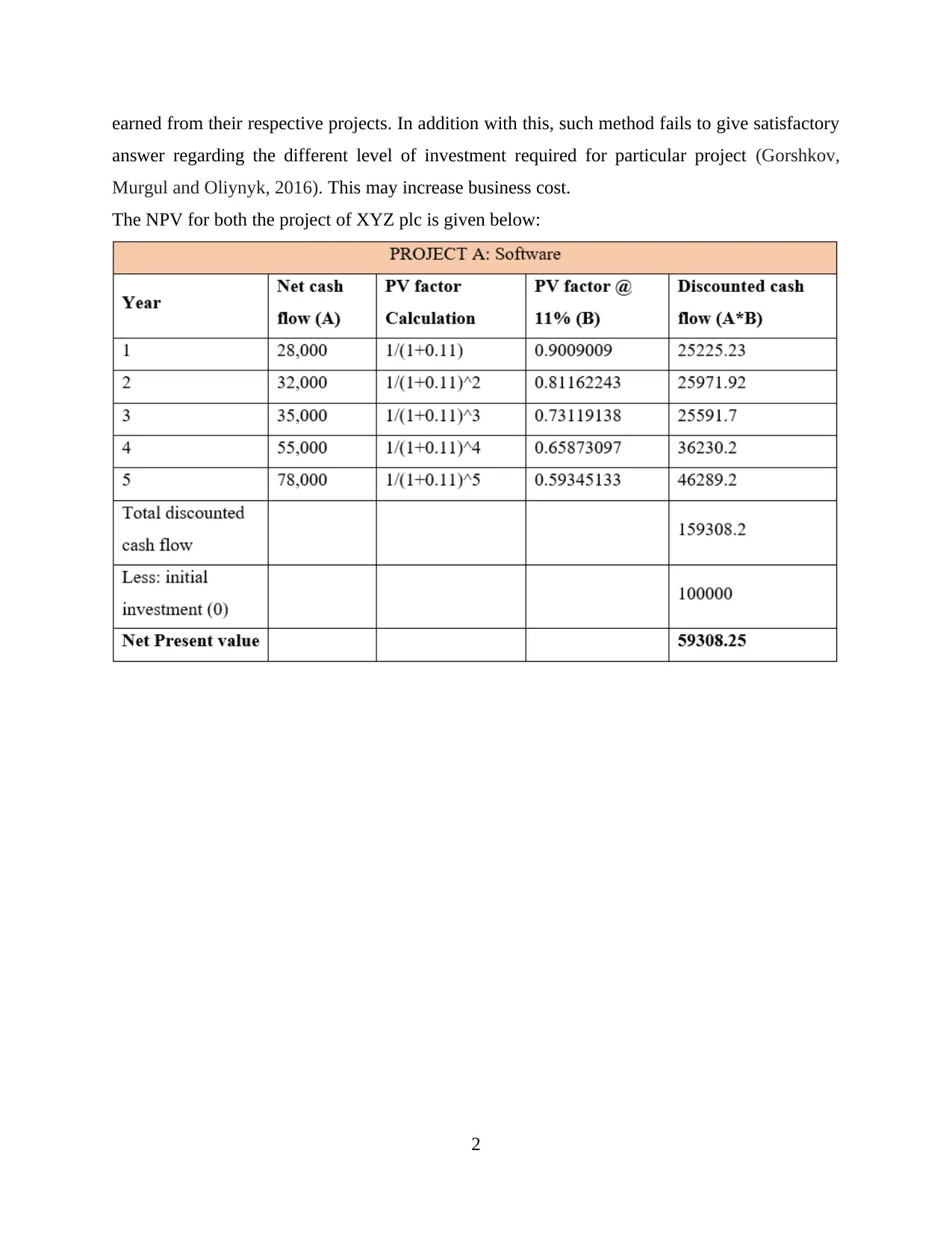
earned from their respective projects. In addition with this, such method fails to give satisfactory
answer regarding the different level of investment required for particular project (Gorshkov,
Murgul and Oliynyk, 2016). This may increase business cost.
The NPV for both the project of XYZ plc is given below:
2
answer regarding the different level of investment required for particular project (Gorshkov,
Murgul and Oliynyk, 2016). This may increase business cost.
The NPV for both the project of XYZ plc is given below:
2
Paraphrase This Document
Need a fresh take? Get an instant paraphrase of this document with our AI Paraphraser
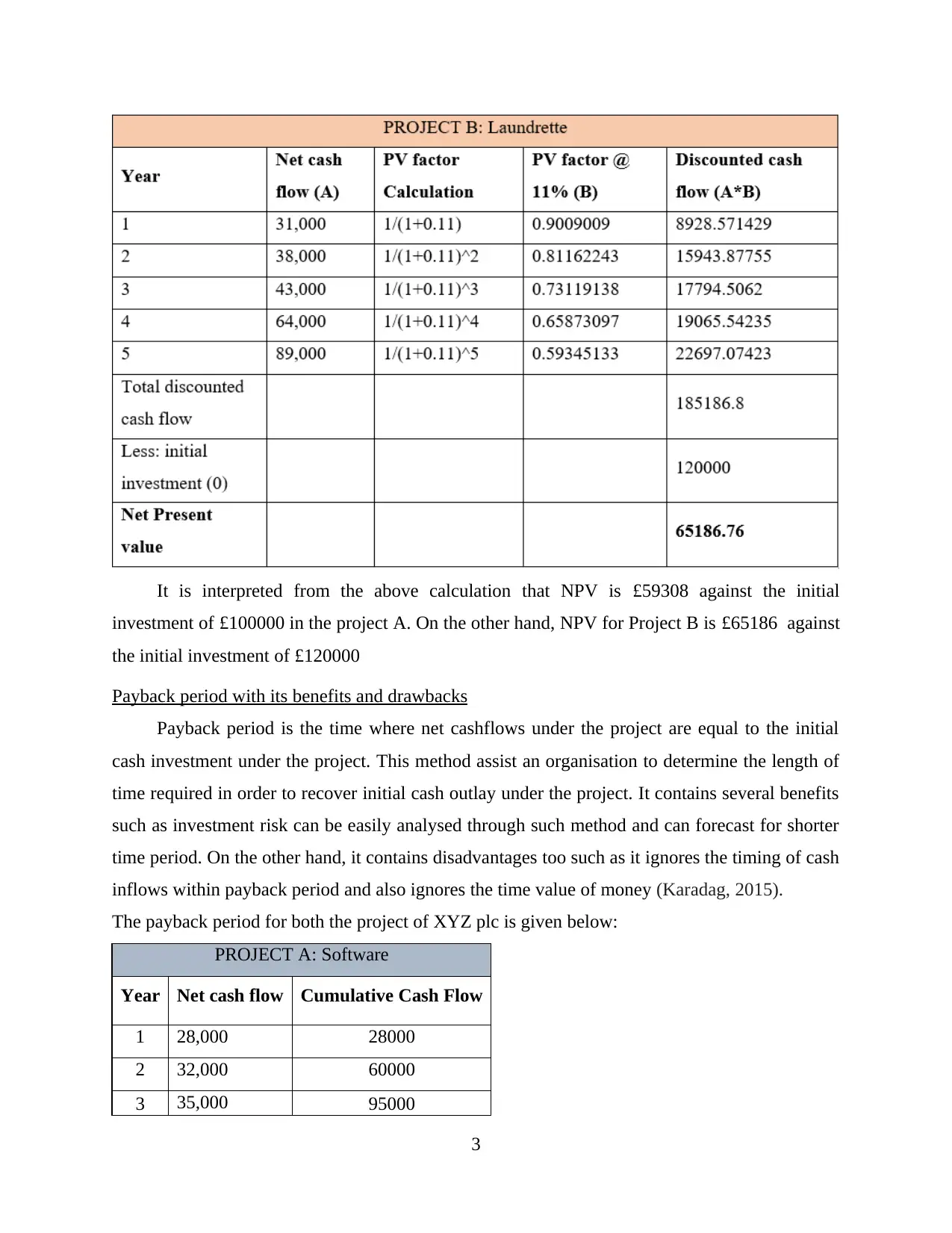
It is interpreted from the above calculation that NPV is £59308 against the initial
investment of £100000 in the project A. On the other hand, NPV for Project B is £65186 against
the initial investment of £120000
Payback period with its benefits and drawbacks
Payback period is the time where net cashflows under the project are equal to the initial
cash investment under the project. This method assist an organisation to determine the length of
time required in order to recover initial cash outlay under the project. It contains several benefits
such as investment risk can be easily analysed through such method and can forecast for shorter
time period. On the other hand, it contains disadvantages too such as it ignores the timing of cash
inflows within payback period and also ignores the time value of money (Karadag, 2015).
The payback period for both the project of XYZ plc is given below:
PROJECT A: Software
Year Net cash flow Cumulative Cash Flow
1 28,000 28000
2 32,000 60000
3 35,000 95000
3
investment of £100000 in the project A. On the other hand, NPV for Project B is £65186 against
the initial investment of £120000
Payback period with its benefits and drawbacks
Payback period is the time where net cashflows under the project are equal to the initial
cash investment under the project. This method assist an organisation to determine the length of
time required in order to recover initial cash outlay under the project. It contains several benefits
such as investment risk can be easily analysed through such method and can forecast for shorter
time period. On the other hand, it contains disadvantages too such as it ignores the timing of cash
inflows within payback period and also ignores the time value of money (Karadag, 2015).
The payback period for both the project of XYZ plc is given below:
PROJECT A: Software
Year Net cash flow Cumulative Cash Flow
1 28,000 28000
2 32,000 60000
3 35,000 95000
3
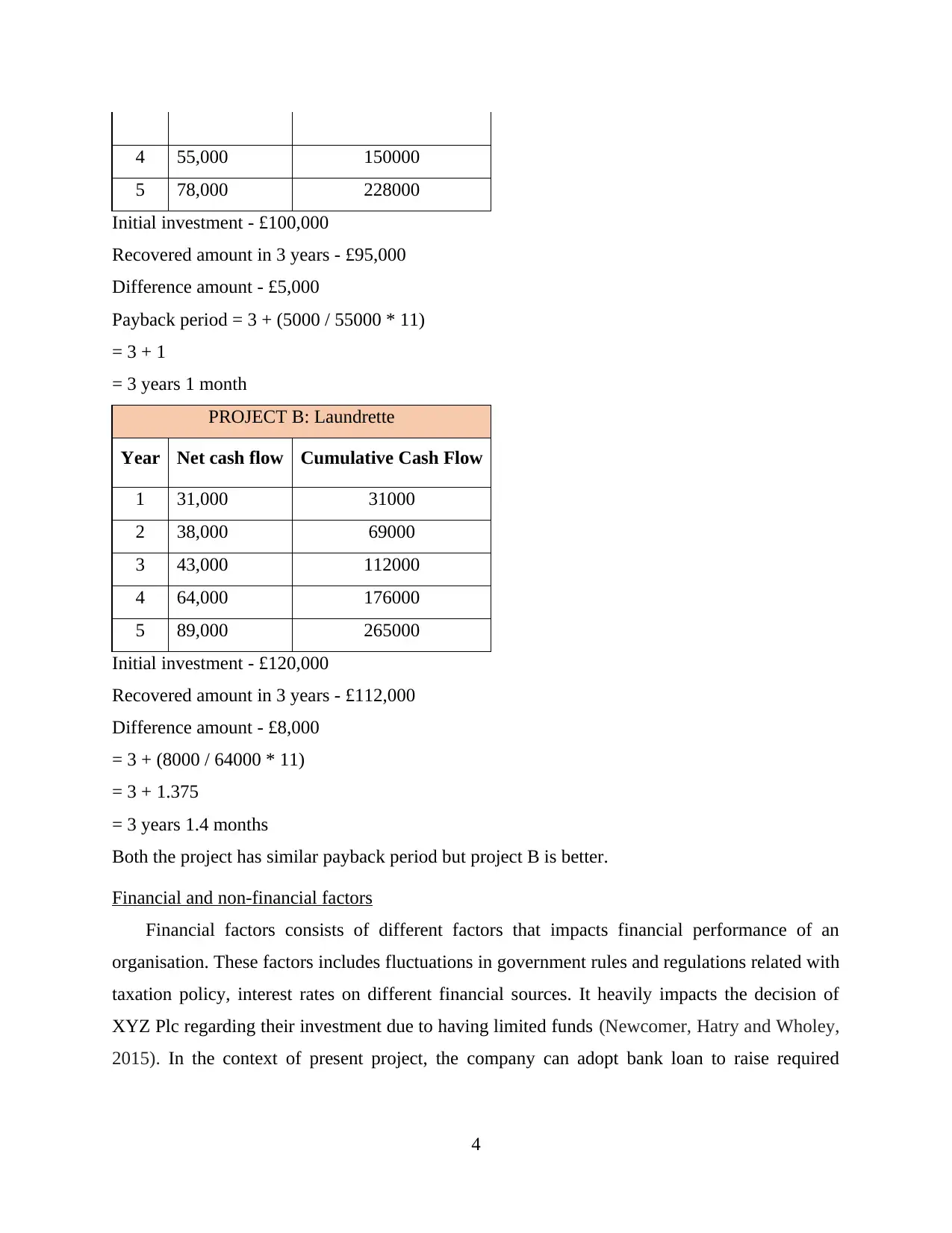
4 55,000 150000
5 78,000 228000
Initial investment - £100,000
Recovered amount in 3 years - £95,000
Difference amount - £5,000
Payback period = 3 + (5000 / 55000 * 11)
= 3 + 1
= 3 years 1 month
PROJECT B: Laundrette
Year Net cash flow Cumulative Cash Flow
1 31,000 31000
2 38,000 69000
3 43,000 112000
4 64,000 176000
5 89,000 265000
Initial investment - £120,000
Recovered amount in 3 years - £112,000
Difference amount - £8,000
= 3 + (8000 / 64000 * 11)
= 3 + 1.375
= 3 years 1.4 months
Both the project has similar payback period but project B is better.
Financial and non-financial factors
Financial factors consists of different factors that impacts financial performance of an
organisation. These factors includes fluctuations in government rules and regulations related with
taxation policy, interest rates on different financial sources. It heavily impacts the decision of
XYZ Plc regarding their investment due to having limited funds (Newcomer, Hatry and Wholey,
2015). In the context of present project, the company can adopt bank loan to raise required
4
5 78,000 228000
Initial investment - £100,000
Recovered amount in 3 years - £95,000
Difference amount - £5,000
Payback period = 3 + (5000 / 55000 * 11)
= 3 + 1
= 3 years 1 month
PROJECT B: Laundrette
Year Net cash flow Cumulative Cash Flow
1 31,000 31000
2 38,000 69000
3 43,000 112000
4 64,000 176000
5 89,000 265000
Initial investment - £120,000
Recovered amount in 3 years - £112,000
Difference amount - £8,000
= 3 + (8000 / 64000 * 11)
= 3 + 1.375
= 3 years 1.4 months
Both the project has similar payback period but project B is better.
Financial and non-financial factors
Financial factors consists of different factors that impacts financial performance of an
organisation. These factors includes fluctuations in government rules and regulations related with
taxation policy, interest rates on different financial sources. It heavily impacts the decision of
XYZ Plc regarding their investment due to having limited funds (Newcomer, Hatry and Wholey,
2015). In the context of present project, the company can adopt bank loan to raise required
4
⊘ This is a preview!⊘
Do you want full access?
Subscribe today to unlock all pages.

Trusted by 1+ million students worldwide
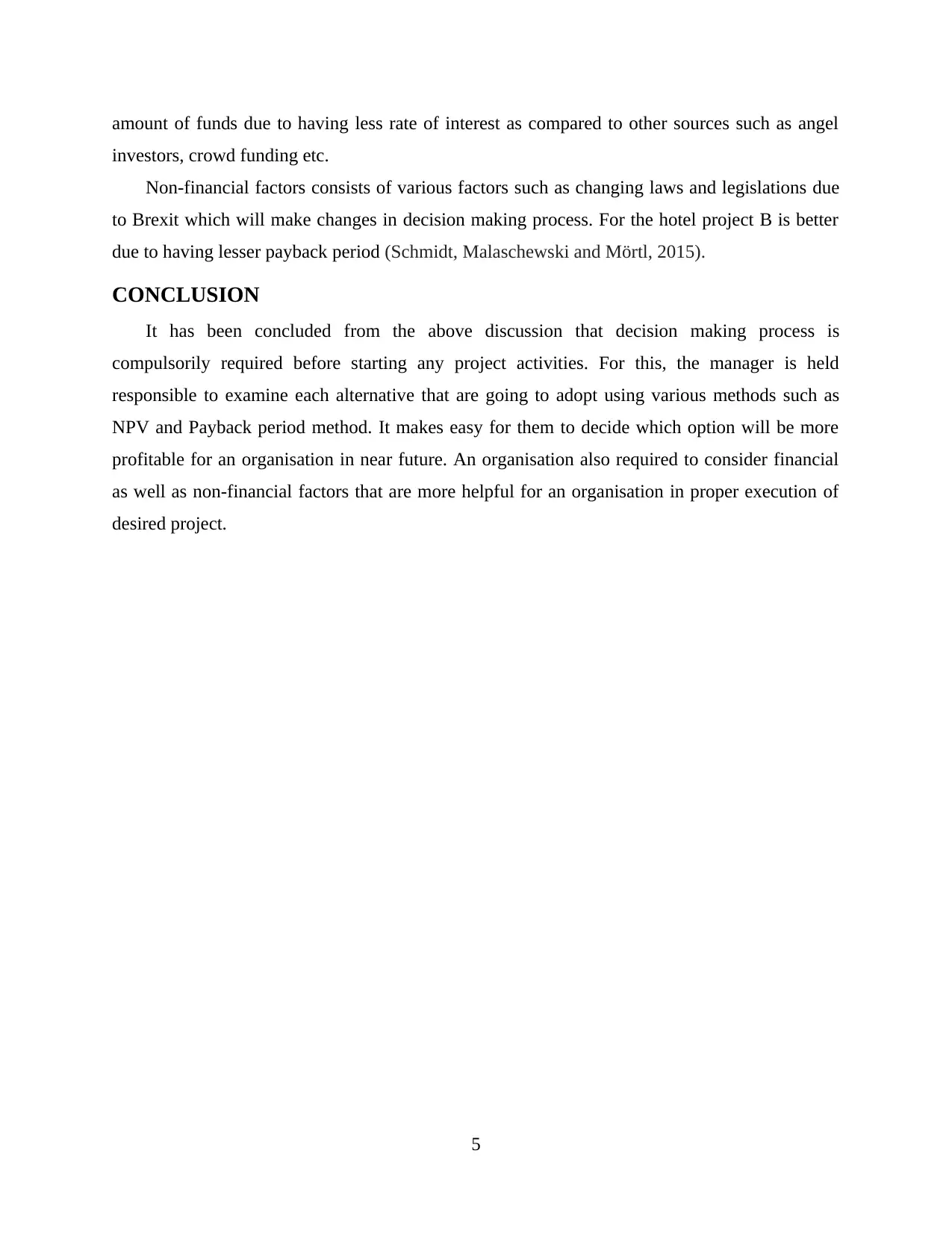
amount of funds due to having less rate of interest as compared to other sources such as angel
investors, crowd funding etc.
Non-financial factors consists of various factors such as changing laws and legislations due
to Brexit which will make changes in decision making process. For the hotel project B is better
due to having lesser payback period (Schmidt, Malaschewski and Mörtl, 2015).
CONCLUSION
It has been concluded from the above discussion that decision making process is
compulsorily required before starting any project activities. For this, the manager is held
responsible to examine each alternative that are going to adopt using various methods such as
NPV and Payback period method. It makes easy for them to decide which option will be more
profitable for an organisation in near future. An organisation also required to consider financial
as well as non-financial factors that are more helpful for an organisation in proper execution of
desired project.
5
investors, crowd funding etc.
Non-financial factors consists of various factors such as changing laws and legislations due
to Brexit which will make changes in decision making process. For the hotel project B is better
due to having lesser payback period (Schmidt, Malaschewski and Mörtl, 2015).
CONCLUSION
It has been concluded from the above discussion that decision making process is
compulsorily required before starting any project activities. For this, the manager is held
responsible to examine each alternative that are going to adopt using various methods such as
NPV and Payback period method. It makes easy for them to decide which option will be more
profitable for an organisation in near future. An organisation also required to consider financial
as well as non-financial factors that are more helpful for an organisation in proper execution of
desired project.
5
Paraphrase This Document
Need a fresh take? Get an instant paraphrase of this document with our AI Paraphraser
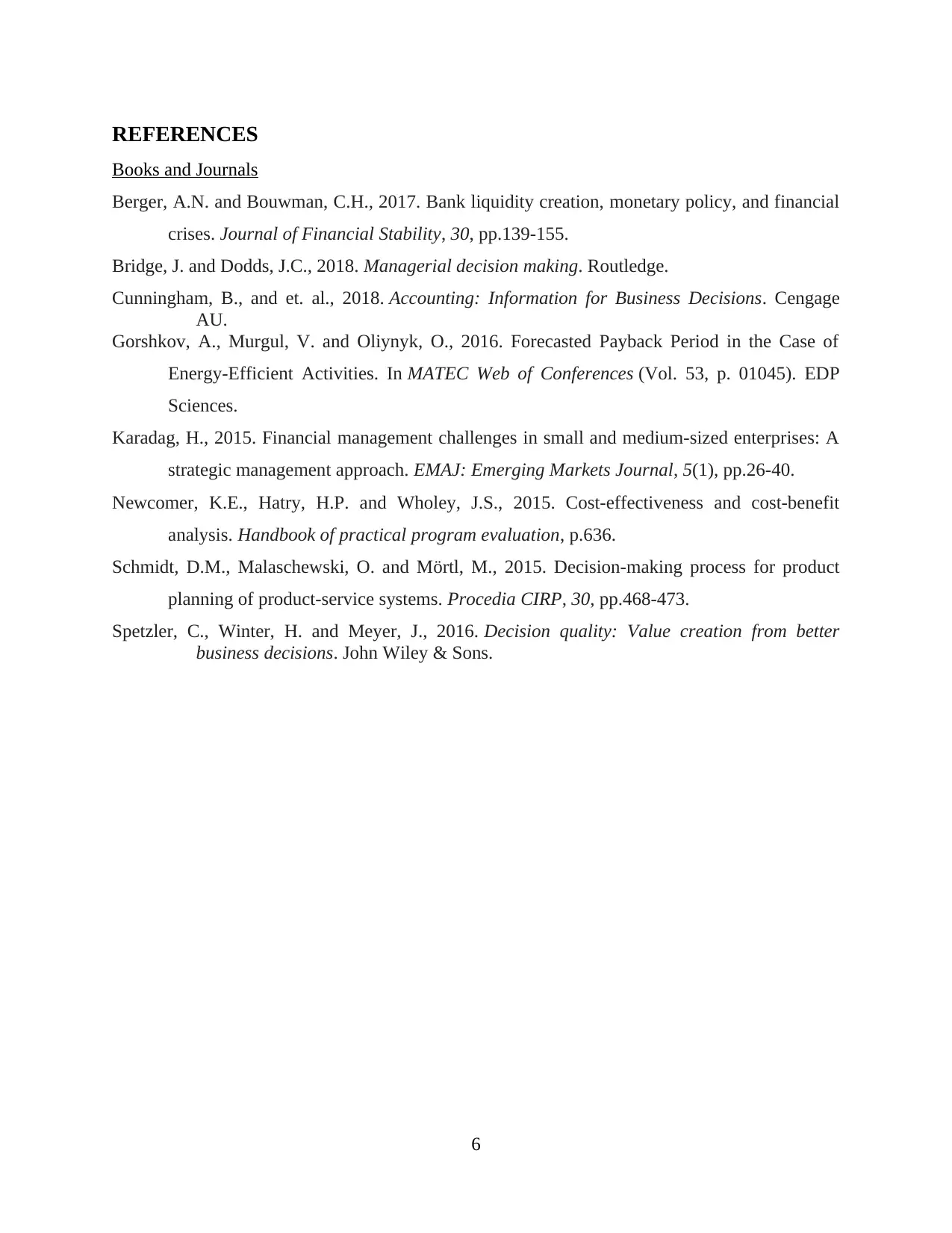
REFERENCES
Books and Journals
Berger, A.N. and Bouwman, C.H., 2017. Bank liquidity creation, monetary policy, and financial
crises. Journal of Financial Stability, 30, pp.139-155.
Bridge, J. and Dodds, J.C., 2018. Managerial decision making. Routledge.
Cunningham, B., and et. al., 2018. Accounting: Information for Business Decisions. Cengage
AU.
Gorshkov, A., Murgul, V. and Oliynyk, O., 2016. Forecasted Payback Period in the Case of
Energy-Efficient Activities. In MATEC Web of Conferences (Vol. 53, p. 01045). EDP
Sciences.
Karadag, H., 2015. Financial management challenges in small and medium-sized enterprises: A
strategic management approach. EMAJ: Emerging Markets Journal, 5(1), pp.26-40.
Newcomer, K.E., Hatry, H.P. and Wholey, J.S., 2015. Cost-effectiveness and cost-benefit
analysis. Handbook of practical program evaluation, p.636.
Schmidt, D.M., Malaschewski, O. and Mörtl, M., 2015. Decision-making process for product
planning of product-service systems. Procedia CIRP, 30, pp.468-473.
Spetzler, C., Winter, H. and Meyer, J., 2016. Decision quality: Value creation from better
business decisions. John Wiley & Sons.
6
Books and Journals
Berger, A.N. and Bouwman, C.H., 2017. Bank liquidity creation, monetary policy, and financial
crises. Journal of Financial Stability, 30, pp.139-155.
Bridge, J. and Dodds, J.C., 2018. Managerial decision making. Routledge.
Cunningham, B., and et. al., 2018. Accounting: Information for Business Decisions. Cengage
AU.
Gorshkov, A., Murgul, V. and Oliynyk, O., 2016. Forecasted Payback Period in the Case of
Energy-Efficient Activities. In MATEC Web of Conferences (Vol. 53, p. 01045). EDP
Sciences.
Karadag, H., 2015. Financial management challenges in small and medium-sized enterprises: A
strategic management approach. EMAJ: Emerging Markets Journal, 5(1), pp.26-40.
Newcomer, K.E., Hatry, H.P. and Wholey, J.S., 2015. Cost-effectiveness and cost-benefit
analysis. Handbook of practical program evaluation, p.636.
Schmidt, D.M., Malaschewski, O. and Mörtl, M., 2015. Decision-making process for product
planning of product-service systems. Procedia CIRP, 30, pp.468-473.
Spetzler, C., Winter, H. and Meyer, J., 2016. Decision quality: Value creation from better
business decisions. John Wiley & Sons.
6
1 out of 8
Related Documents
Your All-in-One AI-Powered Toolkit for Academic Success.
+13062052269
info@desklib.com
Available 24*7 on WhatsApp / Email
![[object Object]](/_next/static/media/star-bottom.7253800d.svg)
Unlock your academic potential
Copyright © 2020–2025 A2Z Services. All Rights Reserved. Developed and managed by ZUCOL.





